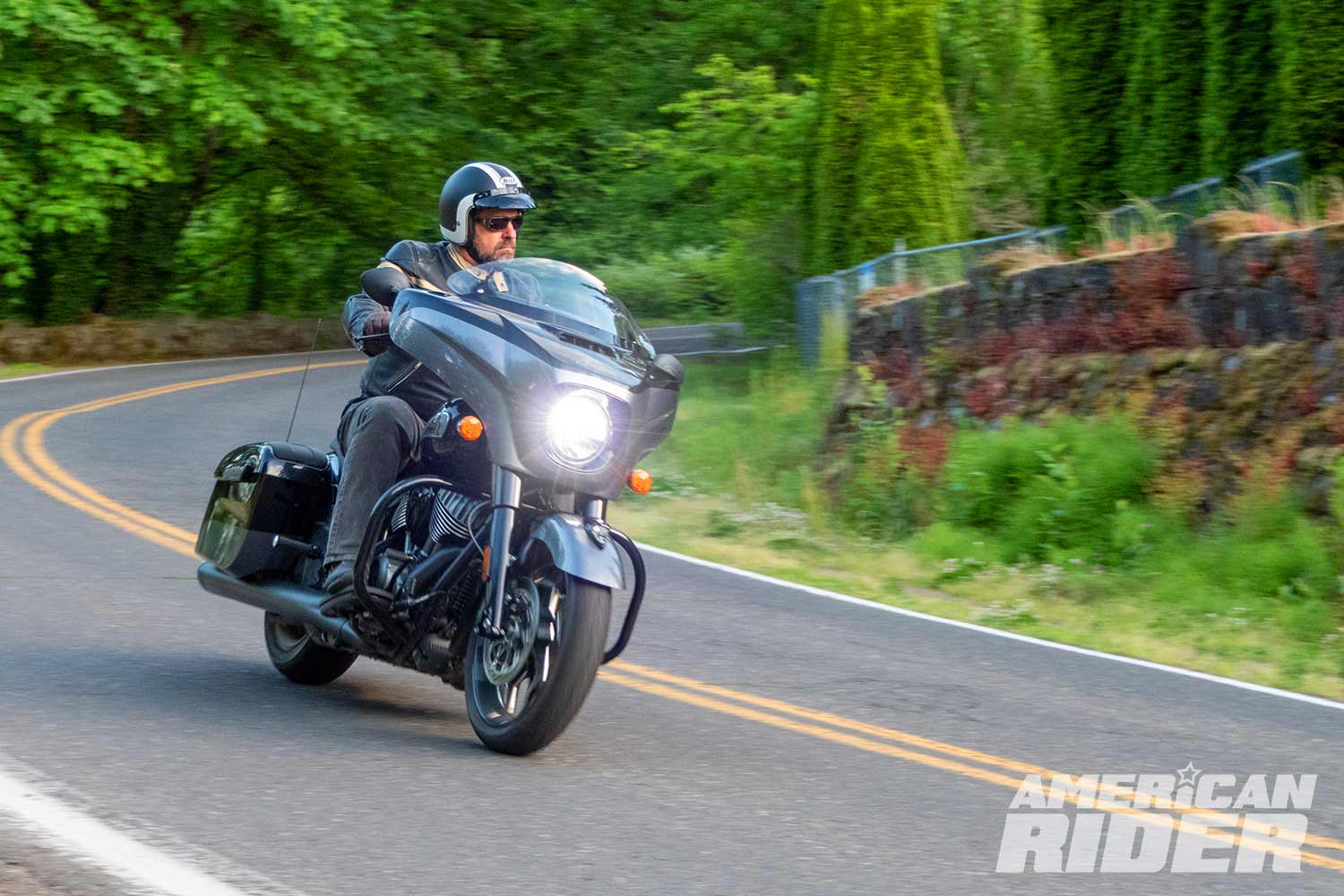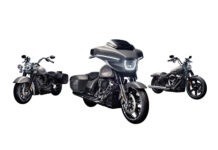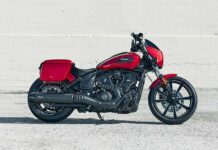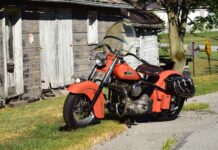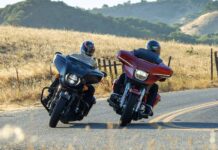The light in the sky from the small city of Prineville, Oregon, quickly fades away as I head east into the gathering darkness on the Indian Chieftain Elite. Behind me, a thin line of dark blue hung on the horizon, but it was also fading by the minute as a moonless, cloudless sky began to fill with stars. I still had a good two hours of riding to go before arriving at my destination, a small cabin on the outskirts of a tiny dot of civilization out in the middle of my home state, an area locals call the “Oregon Outback.”
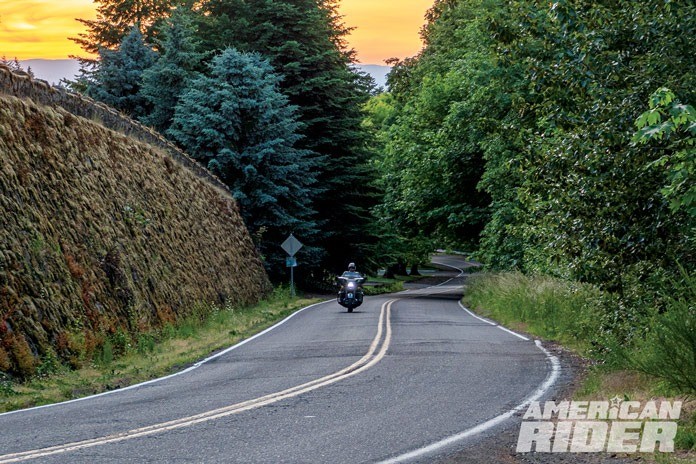
And for good reason. There are more heads of cattle, deer, elk, and other critters out here than people – by a long shot. This is cowboy country, and not in the cinematic sense: men and women on real horses accompanied by tough and trained working dogs wrangle, rope, and cajole heifers from here to over yonder. It’s still the best way to move a lot of cows around the high desert, where more cow paths than roads crisscross the landscape.
But tonight, my horse of choice is a limited-edition 2021 Indian Chieftain Elite bagger, and it’s the most premium offering in Indian’s Chieftain lineup. The base Chieftain retails at $21,999, and the Elite trim adds an abundance of goodies to the package.
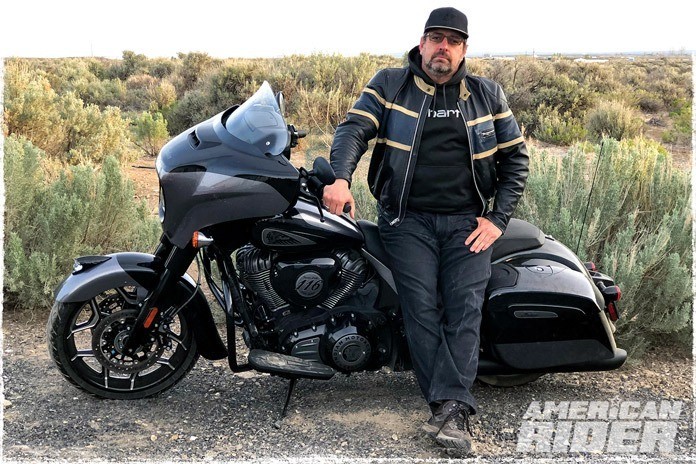
The biggest bonus is the displacement boost, going from 111 cubic inches to 116, and bumping the PowerBand audio system from 100 watts to 400. It also adds the 13.7-inch optional “flare” lipped windscreen as standard, along with a rich two-tone Thunder Black/Vivid Crystal metal-flake paint scheme in dark tones, special satin engine finishes, a handsome machined 19-inch front wheel, logo-emblazoned teardrop floorboards, and LED lighting all around. Plus, there’s only going to be those 120 units produced, so there’s the scarcity and exclusivity to consider for your $34,999.
On this night the Indian Chieftain Elite is galloping across the landscape on Highway 31, a dark, thin ribbon of tarmac that wanders east after splitting from busier, broader Highway 97.

As I descend from the Cascade highlands into the high desert on the far edge of America’s Great Basin, the Elite’s 116-cubic-inch V-Twin is barely breathing in top gear. I know where I’m going, so I tap the Ride Command display and tick a box to turn the screen off. Now, just the speedometer and tachometer remain lit, and the pistons trace their reciprocating journey just 2,000 times per minute as I round curve after curve of Hwy 31 as it drops down to 4,000 feet, the floor of Oregon’s High Desert. It was 67 degrees when I left Prineville and turned onto this very thin line on the map. Now it’s 49 degrees and dropping. I thumb the button to raise the powered windscreen, and the cold wind rises over my helmet.
Related: Indian Pursuit Elite and Chieftain Elite Added to 2023 Indian Motorcycle Lineup
This is Deer Hour, and I’m the target if I don’t take the threat seriously. The revs drop below 1,900 rpm as I slow to 50 mph and ride the broad wave of torque. Around a left-hand sweeper, two yellow reflections glow in the distance, illuminated by the bright Pathfinder LED headlight’s high beam. Bambi is off to the left in a gravel turnout area, and if the fawn is there, mama and an antlered papa are likely close by. I creep past at 35 mph, still in 6th, then slowly roll the throttle back on. The exhaust note from the dual pipes, which are shrouded by a gray heat shield, changes from a chuff to a punchy rumble and snap as the revs build. The curving highway empties out onto a broad range of sagebrush and, eventually, neat rows of crops, soaking in water from hissing, creeping irrigation sprinkler systems that extend far into the darkness, appear in the headlight’s broad beam.
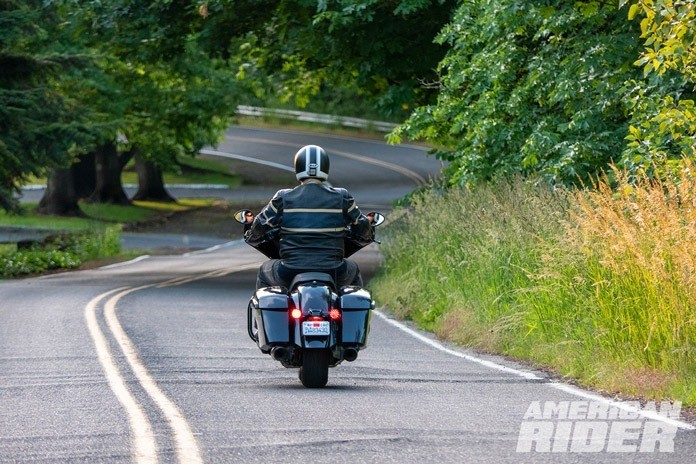
I’m in no hurry and set the Indian’s cruise control at 60 mph as I pass Fort Rock, a basalt formation poking above an ancient lakebed I’m now riding along, the water lost to history as the tectonic forces far below lifted the land up thousands of years ago. I have yet to see another vehicle on the road. It’s like that out here.
In time I arrive at the cabin where warmth awaits and old friends – long separated by the pandemic but now vaccinated and together again – catch up with libations and a roaring outdoor fire.

It’s good to be out on the road again. Winter was tough. On top of the Covid isolation and work stoppages, I broke my shoulder in November and spent the cold and wet months fattening up while doing PT to build back strength and flexibility. Screws now hold my bones together, but the doc says strength will return if I keep up the drills. It was March before I sat on a bike again, and riding was painful. My pants and jacket were a bit tighter when I saddled up in mid-May and pointed toward the empty spaces on the other side of the volcanic Cascade mountain range, but I felt secure on the Indian as we traced along in the darkness.
Related: 2023 Indian Sport Chief Review
Broad, fast corners rounding property lines highlight steering and handling that is neutral and balanced for a big bagger. Proper setup is key. As delivered, steering felt heavy, but adding a few p.s.i. to the rear air shock transformed the handling dynamics.
Once dialed in, the Indian Chieftain Elite holds a confident line in corners and has more cornering clearance than I expected. The triple-disc brakes with ABS take a firm hand (and foot), but that fits with the deliberate nature of the Elite. But the real star of the show is that big stroker of an engine, which makes 126 lb-ft of torque at 2,900 rpm and what feels like 90-odd horsepower a bit further up the tach near the 5,500-rpm redline. But I rarely spun it up past 4,000, as this machine is all about the torque.

That big pool of twist is deep right off idle, and climbing Highway 26 across the flanks of 11,250-foot Mount Hood, kicking it to 5th was all that was needed to quickly loop around chugging semis and slow-poke RVs climbing the grade. Popping the Elite into Sport mode, one of three ride modes built into the brains of the bike, made the power delivery more aggressive.
Tour and Standard are the other two modes, and the major difference is in throttle response. The Standard mode is indeed the best choice for most riding. Tour softens initial power output, and I used it while rolling along long open highways on cruise control, netting an impressive 50 mpg even with the hard bags filled with goodies. Roll the loud handle open, and the bike surges forward, just with less enthusiasm than Sport mode.

Gas mileage (according to the on-bike systems) ranged from the high 30s while in Sport mode with a greedy wrist in the mountains, to the low 50s while ticking along at 60 or so through the broad desert. Range on a 5.5-gallon tank of juice was just over 200 miles if I was well-behaved.
See American Rider‘s Indian Motorcycle reviews here.
The central 7-inch Ride Command LCD touchscreen dominates the cockpit. The Elite includes pretty much every tech trick Ride Command offers, including tire-pressure monitoring, GPS, and a kick-ass Elite-only 400-watt PowerBand audio system with Apple CarPlay. There are a pair of two-way speakers in the batwing-esque fairing and two more in the lids of the hardshell side cases. While the system has good clarity, a lot of volume, and bathes the rider in sound, I would have appreciated a bit more bass punch.
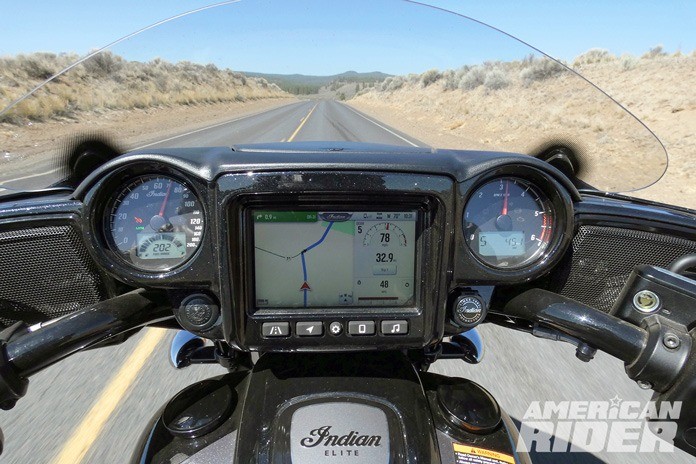
The big LCD touchscreen is highly configurable across six different primary display options, one each for music, GPS, phone ops, a mixed feed, travel data, and bike systems updates. I usually kept it on the “road” screen (three rotating screen options), and I set it up to show GPS, music info, gas mileage, and a small gauge box that showed speed, RPM, and gear position. Very handy and legible. This is all in addition to the two analog clocks that flank the display, with a traditional speedometer on the left that includes an inset LCD showing fuel level and range, and a tach on the right that also shows the odometer and gear position.
If you think that sounds like way too much information while riding, I’ll admit it was a bit overwhelming at first. Thankfully, pushing the middle Settings button below the screen brings up a brightness display and an off option. As in off, not just blank or showing the time or a dull gray glow. The screen is OFF. Poking a handlebar button or center button brings it right back, but at least you get the option to ride analog (for the most part) if you feel like it. Off was the best option as I rolled across some of the vast expanse of Oregon’s more desolate tracts at night, and the capability to dim the instrument backlights would be a welcome update. They’re bright.
But during daylight hours, I quickly got used to the information flow and enjoyed the copious data Ride Command offered beyond GPS, which includes an elevation trace history, instant MPG data, weather info, tripmeters, and a good old AM/FM radio, along with Bluetooth, of course. You can also hardwire your phone to the system so it charges while it sits in a quick-access cubby by the windscreen. A four-way pointer and other controls on the bar pods makes navigating the screen easy while riding, since much of the touch ability is locked out for safety while riding. The pointer also controls volume and music tracks.
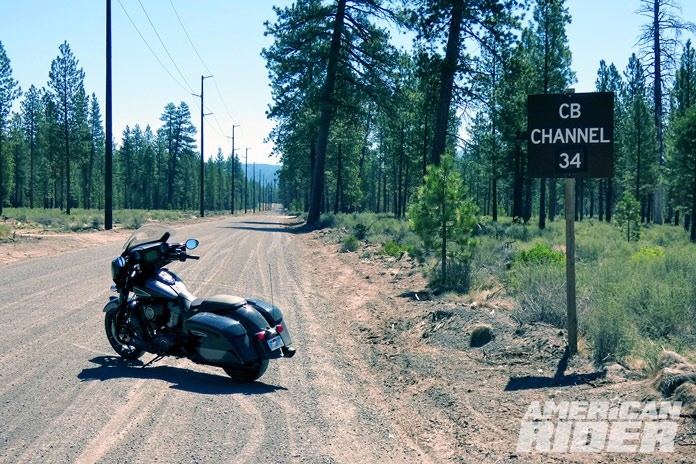
After several days roaming the wilder reaches of Oregon, it was time to head back to civilization and the daily grind. But on the way back, I hopped highways until I hooked into Highway 20, which borders massive Detroit Lake near the western center of the state. The small town of Detroit (Oregon) sits at one end, and in the summer of 2020, massive wildfires tore through the towering forests around the lake and nearly wiped the picturesque town off the map.
Detroit was a popular stop for Oregon riders, as it offered 1950s-era flavor at places like the Cedars Lounge, a small gas station, and dozens of rentable cabins and cabanas along the lakeshore. All are gone now. The scope of the fire was more painful and massive than I expected as I tiptoed through the devastation zone at 40 mph, a temporary speed limit since the road was pitted, scarred, and damaged from the blaze and the efforts to fight it. Only chimneys remained at many homesites.
Soon enough I was merging with semis and Subarus on Interstate 5 and locked the cruise control in at 70 for the short home stretch on the super-slab, Doobie Brothers pouring from the PowerBand audio system.
Nitpicks? Oh, if that windscreen would just go another inch or two higher, it would be ideal for this 6-foot-1 rider. With the screen lowered, helmet buffeting was annoying at highway speeds, but it’s largely reduced once the screen is raised all the way up (and it can be parked anywhere in between), and integrated venting at the bottom of the screen helps smooth airflow. Indian offers a taller windscreen as an accessory ($239) that adds a bit more than 6 inches of height over the flare windscreen, but I didn’t get a chance to try it out before press time.
The Indian Chieftain Elite is a solid touring bagger with a stout motor and sharp style. It is loaded with special touches from the factory that elevates the price above the standard Chieftain. Whether that justifies the premium is in the eye of the rider. To be sure, riders looking for a solid street cruiser that can pull double duty as a sweetheart touring mount need look no further.
I had zero problems during my 800-plus miles in the saddle, and many good memories as I rode through the darkness and the light of the far reaches of Oregon.
If you get a chance, you should do the same.
Find more information at Indian Motorcycle’s website.
SIDEBAR: Indian Elite Vs. Harley CVO
While the Elite is certainly a luxurious and capable road machine, it’s also clearly targeting Harley’s $40,599 Street Glide CVO in terms of price, performance, and exclusivity. Both feature a similar bagger layout with a bar-mounted batwing-style fairing and two hard bags. So what are the differences? Let’s start in the engine bay.
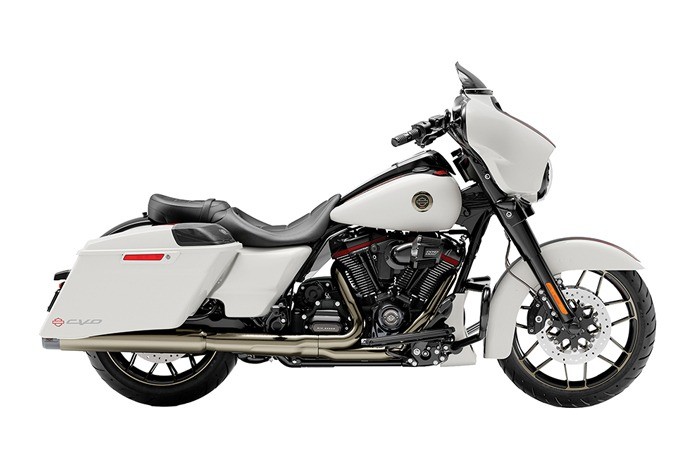
The Elite is powered by Indian’s largest stock version of the air-cooled Thunderstroke engine at 116 cubic inches (1,901cc), and features pushrods operating two valves per cylinder. Harley’s air-cooled Milwaukee-Eight on the CVO goes one cube bigger at 117ci (1,917cc), packs four valves per can, and, just like the Indian motor, puts out a stated 126 lb-ft of torque – but at almost 1,000 rpm higher in the powerband. Horsepower? Neither maker will specify numbers, and really, these motors are all about torque anyway, so despite some technical differences, it’s a bit of a draw.
Factory customs like these usually feature all the bells and whistles, and again, the tech suites are comparable in many ways, while Harley packs in some extra special sauce. Both bikes feature cruise control and a single headlight packed with high-powered LEDs, but the CVO’s Daymaker system also includes tech that sends light into corners as the bike turns.
Related: 2023 Harley-Davidson CVO Glides | First Ride
Both bikes feature 4-speaker, 400-watt audio systems with big touchscreens, GPS, Bluetooth, and extensive bike-status monitoring, but Harley includes a helmet-compatible Bluetooth headset with voice recognition with their Boom! Box GTS audio suite, as well as speakers from Rockford Fosgate. On the other hand, the Indian features the familiar Apple CarPlay in its quiver, while the Glide does not.
And while both bikes feature triple-disc ABS braking systems, the CVO Street Glide expands those capabilities with the new RDRS safety suite, which uses an IMU to monitor sketchy moments of low traction when leaned over.
Meanwhile, the Indian comes in about 30 pounds lighter than the CVO fully fueled, and includes that swank motorized windscreen, which can be stopped anywhere in its 6-inch range of motion. Harley’s screen is fixed in place.
And let’s face it, both bikes look good – and similar. The Elite is graced with a subtle two-tone color scheme with a metal-flake sparkle to liven it up, a paint process that supposedly requires 24 hours of labor. Satin finishes substitute for chrome. The Harley can be had in a matte Bronze Armor finish, a slick red-and-black scheme, or a cool retro white with black and red stripes, and red engine highlights that look pretty damn sweet as well.
Is the CVO worth the extra five grand over the Indian? The Reflex safety system is a nice insurance policy against rider errors, so if you tend to be an aggressive rider and head for the corners, that may be the dealmaker.
The Elite is just one of 120 that are going to roll off the line this year, so if exclusivity is your thing, the money saved over the CVO may help seal that deal.
Choose your weapon. -BR


